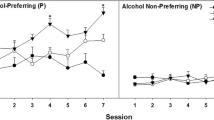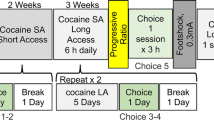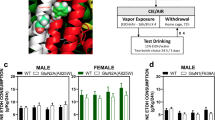Abstract
Ethanol drinking was assessed in the P/NP, HAD1/LAD1, and HAD2/LAD2 lines of rats under environmental conditions that produce schedule-induced polydipsia. Female rats (n = 8/line), maintained at 85% of free-feeding body weights, underwent daily 1-h sessions during which 45-mg food pellets were delivered every 60 s. Water, 2, 4, 8, 16, or 32% w/v ethanol solution was available from a single bottle for 8 consecutive sessions at each concentration, with blood-ethanol levels (BELs) determined after selected sessions. P and HAD2 rats drank more water and ethanol than their non-preferring counterparts, while HAD1 and LAD1 rats did not differ. Ethanol intake and BELs were positively correlated (r = 0.75) across lines. Finally, rats were allowed 14 daily choice sessions with 8% ethanol and water concurrently available. Water intake generally exceeded ethanol intake in all lines, while P rats drank similar amounts of both fluids. These line differences indicate pleiotropic effects of genes that mediate ethanol intake and schedule-induced behaviors.





Similar content being viewed by others
References
Cicero TJ (1979) A critique of animal analogues of alcoholism. In: Majchrowicz E, Noble EP (eds) Biochemistry and pharmacology of ethanol, vol 2. Plenum Press, New York, pp 533–560
Crabbe JC (1999) Animal models in neurobehavioral genetics: methods for estimating genetic correlation. In: Mormède P, Jones BC (eds) Neurobehavioral genetics: methods and applications. CRC press, Boca Raton, FL, pp 121–138
Crabbe JC (2002) Alcohol and genetics: new models. Am J Med Gen 114:969–974
Crabbe JC, Phillips TJ, Kosobud A, Belknap JK (1990) Estimation of genetic correlation: interpretation of experiments using selectively bred and inbred animals. Alcohol Clin Exp Res 14:141–151
Enoch MA, Goldman D (2001) The genetics of alcoholism and alcohol abuse. Curr Psychiat Rep 3:144–151
Falk JL (1961) Production of polydipsia in normal rats by an intermittent food schedule. Science 133:195–196
Falk JL (1971) The nature and determinants of adjunctive behavior. Physiol Behav 6:577–588
Falk JL (1981) The place of adjunctive behavior in drug abuse research. NIDA Res Monograph 37:271–278
Falk JL (1998) Drug abuse as an adjunctive behavior. Drug Alc Dep 52:91–98
Falk JL, Samson HH, Winger G (1972) Behavioral maintenance of high concentrations of blood ethanol and physical dependence in the rat. Science 177:811–813
Files FJ, Samson HH, Denning CE, Marvin S (1998) Comparison of alcohol-preferring and nonpreferring selectively bred rat lines, II Operant self-administration in a continuous-access situation. Alcohol Clin Exp Res 22:2147–2158
Freed EX, Lester D (1970) Schedule-induced consumption of alcohol: calories or chemotherapy? Physiol Behav 5:555–560
Gatto GJ, Murphy JM, Waller MB, McBride WJ, Lumeng L, Li T-K (1987) Persistence of tolerance to a single dose of ethanol in the selectively bred alcohol-preferring P rats. Pharamcol Biochem Behav 28:111–115
Gatto GJ, McBride WJ, Murphy JM, Lumeng L, Li T-K (1994) Ethanol self-infusion into the ventral tegmental area by alcohol-preferring rats. Alcohol 11:557–564
Goldowitz D, Matthews DB, Hamre KM, Mittleman G, Chesler EJ, Becker HC, Lopez MF, Jones SR, Mathews TA, Miles MF, Kerns R, Grant KA (2006) Progress in using mouse inbred strains, consomics, and mutants to identify genes related to stress, anxiety, and alcohol phenotypes. Alcohol Clin Exp Res 30:1066–1078
Heintzelman ME, Best J, Senter RJ (1976) Polydipsia-induced alcohol dependency in rats: a reexamination. Science 191:482–483
Lester D (1961) Self-maintenance of intoxication in the rat. Q J Stud Alcohol 22:223–231
Li T-K, Lumeng L (1984) Alcohol preference and voluntary alcohol intakes of inbred rat strains and the National Institutes of Health heterogenous stock of rats. Alcohol Clin Exp Res 8:485–486
Li T-K, Lumeng L, McBride WJ, Murphy JM (1991) Rodent lines selected for factors affecting alcohol consumption. Alcohol Alcohol Suppl 1:91–96
Li TK, Lumeng L, Doolittle DP (1993) Selective breeding for alcohol preference and associated responses. Behav Gen 23:163–170
Lumeng L, Hawkins DT, Li TK (1977) New strains of rats with alcohol preference and nonpreference. In: Thurman RG (ed) Alcohol and aldehyde metabolizing systems, vol 3. Alcohol and Aldehyde Metabolizing Systems Academic Press, New York, pp 537–544
Lumeng L, Murphy JM, McBride WJ, Li T-K (1995) Genetic influences on alcohol preference in animals. In: Begleiter H, Kissin B (eds) The genetics of alcoholism. Oxford University Press, New York, pp 165–201
Mittleman G, Van Brunt CL, Matthews DB (2003) Schedule-induced ethanol self-administration in DBA/2 J and C57BL/6 J mice. Alcohol Clin Exp Res 27:918–925
Murphy JM, Gatto GJ, Waller MB, McBride WJ, Lumeng L, Li T-K (1986) Effects of scheduled access on ethanol intake by the alcohol-preferring P lines of rats. Alcohol 3:331–336
Murphy JM, Stewart RB, Bell RL, Badia-Elder NE, Carr LG, McBride WJ, Lumeng L, Li T-K (2002) Phenotypic and genotypic characterization of the Indiana University rat lines selectively bred for high and low alcohol preference. Behav Gen 32:363–388
National Research Council (1996) Guide for the care and use of laboratory animals. National Research Council, Washington DC
Samson HH, Czachowski CL (2003) Behavioral measures of alcohol self-administration and intake control: rodent models. Int Rev Neurobiol 54:107–143
Samson HH, Files FJ, Denning C, Marvin S (1998) Comparison of alcohol-preferring and nonpreferring selectively bred rat lines. I. Ethanol initiation and limited access operant self-administration. Alcohol Clin Exp Res 22:2133–2146
Tang M, Falk JL (1983) Production of physical dependence on ethanol by a short drinking episode each day. Pharmacol Biochem Behav 19:53–55
Tang M, Brown C, Falk JL (1982) Complete reversal of chronic ethanol polydipsia by schedule withdrawal. Pharmacol Biochem Behav 16:155–158
Tomie A, Miller WC, Dranoff E, Pohorecky LA (2006) Intermittent presentations of ethanol sipper tube induce ethanol drinking in rats. Alcohol Alcohol 41:225–230
Waller MB, McBride WJ, Lumeng L, Li T-K (1982) Induction of dependence on ethanol by free-choice drinking in alcohol-preferring rats. Pharmacol Biochem Behav 16:501–507
Waller MB, McBride WJ, Gatto GJ, Lumeng L, Li T-K (1984) Intragastric self-infusion of ethanol by ethanol-preferring and-nonpreferring lines of rats. Science 225:78–80
Williams SL, Tang M, Falk JL (1992) Prior exposure to a running wheel and scheduledfood attenuates polydipsia acquisition. Physiol Behav 52:481–483
Acknowledgement
Supported by National Institutes of Alcohol Abuse and Alcoholism grants AA07611, AA10722.
Author information
Authors and Affiliations
Corresponding author
Additional information
Edited by Tamara Phillips.
Rights and permissions
About this article
Cite this article
Gilpin, N.W., Badia-Elder, N.E., Elder, R.L. et al. Schedule-induced Polydipsia in Lines of Rats Selectively Bred for High and Low Ethanol Preference. Behav Genet 38, 515–524 (2008). https://doi.org/10.1007/s10519-008-9224-1
Received:
Accepted:
Published:
Issue Date:
DOI: https://doi.org/10.1007/s10519-008-9224-1




